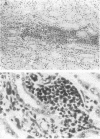Abstract
We present evidence that supports the carrier status of dogs experimentally infected with Ehrlichia canis after treatment with doxycycline. Canine ehrlichiosis was induced in five dogs by intravenous inoculation with E. canis-infected DH82 cells. All animals developed mild clinical signs of transient fever, body weight loss, thrombocytopenia, and increased gamma globulin levels in plasma. An indirect fluorescent-antibody test (IFA) revealed that all dogs had seroconverted (titer, 5,120) by day 10 postinoculation (p.i.). E. canis was reisolated from blood samples collected at intervals throughout the 2-month period p.i. Doxycycline was administered orally once daily at 10 mg/kg of body weight per day for 1 week starting at 2 months p.i. Following treatment, gamma globulin levels in plasma were decreased. At necropsy on days 54 to 59 after the start of treatment, spleen, liver, kidney, and lymph nodes were collected for E. canis culture and histopathologic examination. Although the dogs did not show significant clinical signs during or after treatment with the antibiotic, E. canis was reisolated from the blood and tissue samples of three of five dogs. A 16-fold reduction in IFA titer was noted in two dogs which were negative for E. canis reisolation at day 49 after the start of treatment, whereas a zero- to fourfold reduction in IFA titer was seen in the remaining three dogs. Western immunoblot reactions to higher-molecular-size E. canis antigens in the sera of two dogs which were negative for E. canis on blood culture decreased, whereas they remained continuously high or only transiently decreased for the duration of the study for antigens in the sera of three dogs from which E. canis was reisolated. Histopathologically, prominent plasmacytosis in the kidney cortex was present in three dogs from which E. canis was reisolated, whereas the kidney cortices of two dogs had moderate to minor plasmacytosis. These findings pose questions regarding the efficacy, dosage and duration of doxycycline treatment in dogs with E. canis infection. In addition, it was shown that IFA and Western immunoblotting may aid in assessing the efficacy of antibiotic therapy when definitive reisolation procedures are not readily available.
Full text
PDF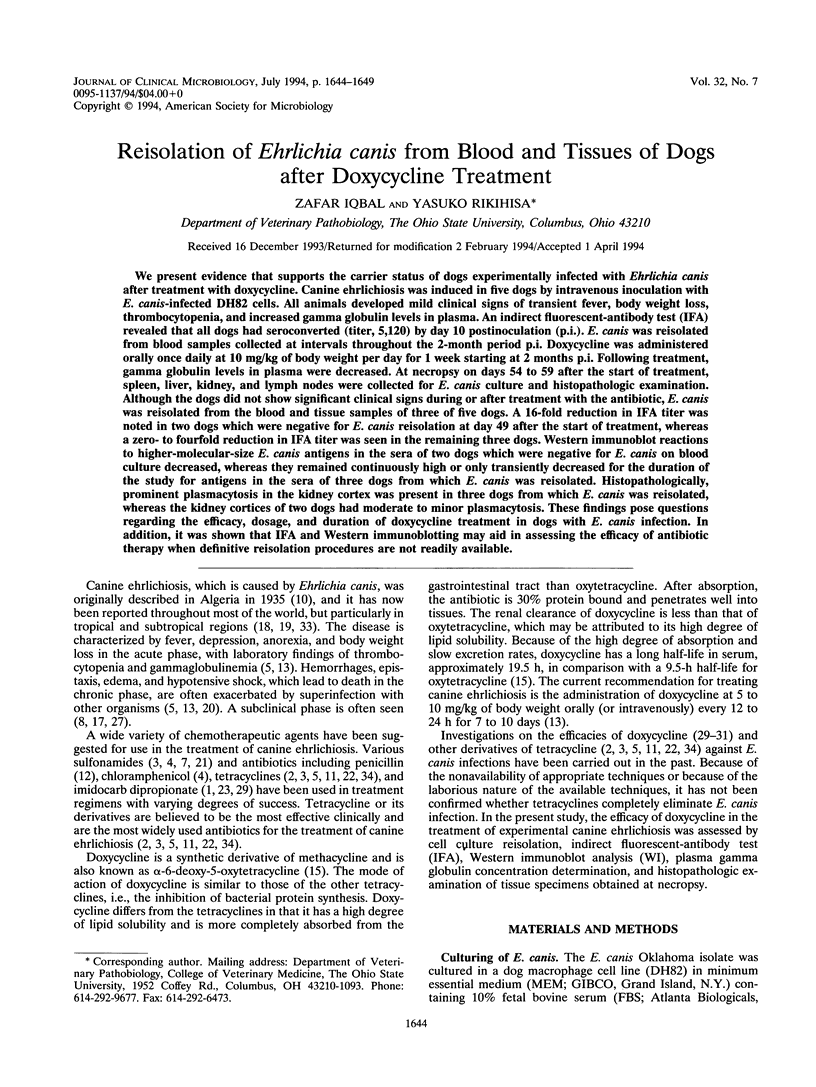

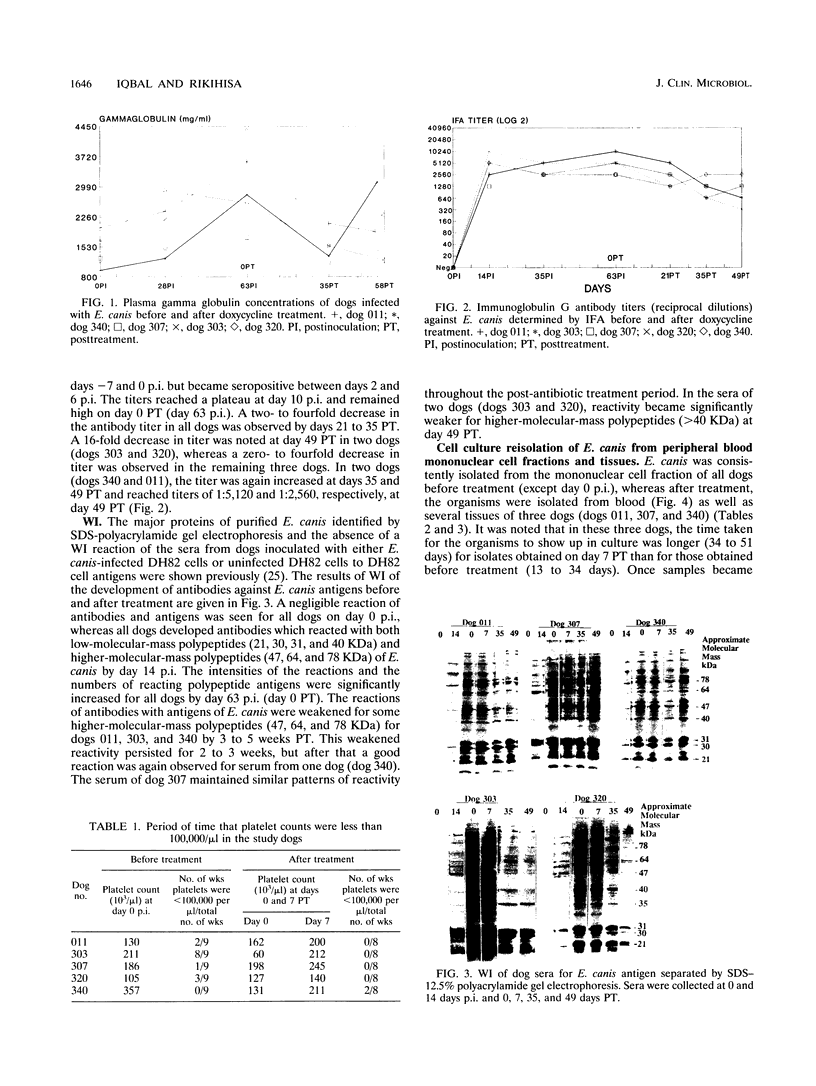
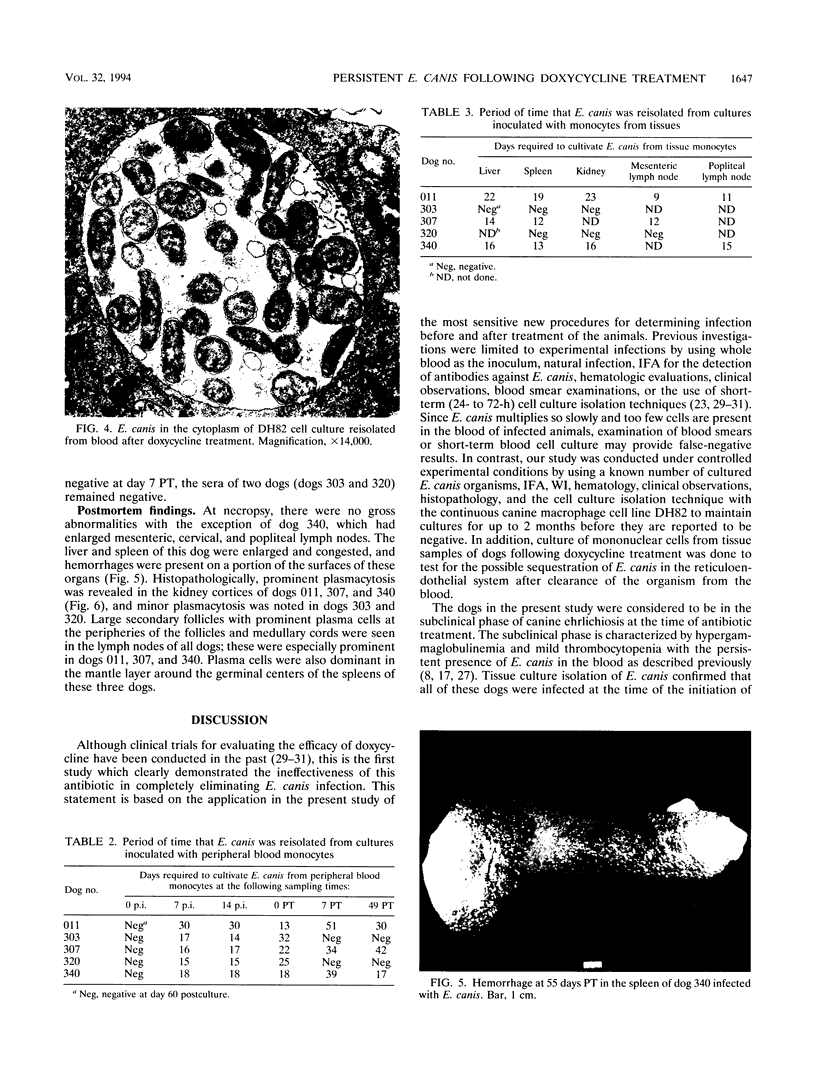

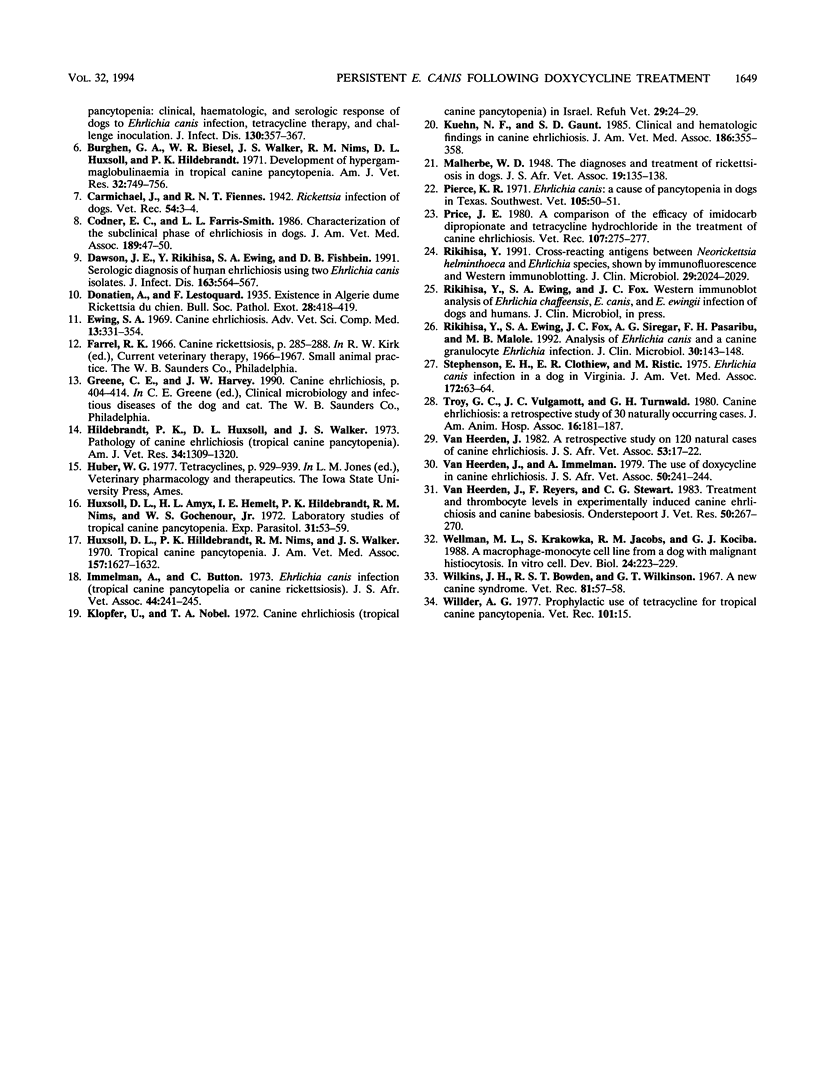
Images in this article
Selected References
These references are in PubMed. This may not be the complete list of references from this article.
- Amyx H. L., Huxsoll D. L., Zeiler D. C., Hildebrandt P. K. Therapeutic and prophylactic value of tetracycline in dogs infected with the agent of tropical canine pancytopenia. J Am Vet Med Assoc. 1971 Dec 1;159(11):1428–1432. [PubMed] [Google Scholar]
- BOOL P. H., SUTMOLLER P. Ehrlichia canis infections in dogs on Aruba (Netherlands Antilles). J Am Vet Med Assoc. 1957 May 1;130(9):418–420. [PubMed] [Google Scholar]
- Buckner R. G., Ewing S. A. Experimental treatment of canine ehrlichiosis and haemobartonellosis. J Am Vet Med Assoc. 1967 Jun 15;150(12):1524–1530. [PubMed] [Google Scholar]
- Buhles W. C., Jr, Huxsoll D. L., Ristic M. Tropical canine pancytopenia: Clinical, hematologic, and serologic response of dogs to Ehrlichia canis infection, tetracycline therapy, and challenge inoculation. J Infect Dis. 1974 Oct;130(4):357–367. doi: 10.1093/infdis/130.4.357. [DOI] [PubMed] [Google Scholar]
- Burghen G. A., Beisel W. R., Walker J. S., Nims R. M., Huxsoll D. L., Hildebrandt P. K. Development of hypergammaglobulinemia in tropical canine pancytopenia. Am J Vet Res. 1971 May;32(5):749–756. [PubMed] [Google Scholar]
- Codner E. C., Farris-Smith L. L. Characterization of the subclinical phase of ehrlichiosis in dogs. J Am Vet Med Assoc. 1986 Jul 1;189(1):47–50. [PubMed] [Google Scholar]
- Dawson J. E., Rikihisa Y., Ewing S. A., Fishbein D. B. Serologic diagnosis of human ehrlichiosis using two Ehrlichia canis isolates. J Infect Dis. 1991 Mar;163(3):564–567. doi: 10.1093/infdis/163.3.564. [DOI] [PubMed] [Google Scholar]
- Ewing S. A. Canine ehrlichiosis. Adv Vet Sci Comp Med. 1969;13:331–353. [PubMed] [Google Scholar]
- Hildebrandt P. K., Huxsoll D. L., Walker J. S., Nims R. M., Taylor R., Andrews M. Pathology of canine ehrlichiosis (tropical canine pancytopenia). Am J Vet Res. 1973 Oct;34(10):1309–1320. [PubMed] [Google Scholar]
- Huxsoll D. L., Amyx H. L., Hemelt I. E., Hildebrandt P. K., Nims R. M., Gochenour W. S., Jr Laboratory studies of tropical canine pancytopenia. Exp Parasitol. 1972 Feb;31(1):53–59. doi: 10.1016/0014-4894(72)90046-x. [DOI] [PubMed] [Google Scholar]
- Huxsoll D. L., Hildebrandt P. K., Nims R. M., Walker J. S. Tropical canine pancytopenia. J Am Vet Med Assoc. 1970 Dec 1;157(11):1627–1632. [PubMed] [Google Scholar]
- Immelman A., Button C. Ehrlichia canis infection. (Tropical canine pancytopaenia or canine rickettsiosis). J S Afr Vet Assoc. 1973 Sep;44(3):241–245. [PubMed] [Google Scholar]
- Kuehn N. F., Gaunt S. D. Clinical and hematologic findings in canine ehrlichiosis. J Am Vet Med Assoc. 1985 Feb 15;186(4):355–358. [PubMed] [Google Scholar]
- Price J. E., Dolan T. T. A comparison of the efficacy of imidocarb dipropionate and tetracycline hydrochloride in the treatment of canine ehrlichiosis. Vet Rec. 1980 Sep 20;107(12):275–277. doi: 10.1136/vr.107.12.275. [DOI] [PubMed] [Google Scholar]
- Rikihisa Y. Cross-reacting antigens between Neorickettsia helminthoeca and Ehrlichia species, shown by immunofluorescence and Western immunoblotting. J Clin Microbiol. 1991 Sep;29(9):2024–2029. doi: 10.1128/jcm.29.9.2024-2029.1991. [DOI] [PMC free article] [PubMed] [Google Scholar]
- Rikihisa Y., Ewing S. A., Fox J. C., Siregar A. G., Pasaribu F. H., Malole M. B. Analyses of Ehrlichia canis and a canine granulocytic Ehrlichia infection. J Clin Microbiol. 1992 Jan;30(1):143–148. doi: 10.1128/jcm.30.1.143-148.1992. [DOI] [PMC free article] [PubMed] [Google Scholar]
- Stephenson E. H., Ristic M. Retrospective study of an Ehrlichia canis epizootic around Phoenix, Arizona. J Am Vet Med Assoc. 1978 Jan 1;172(1):63–65. [PubMed] [Google Scholar]
- Van Heerden J., Reyers F., Stewart C. G. Treatment and thrombocyte levels in experimentally induced canine ehrlichiosis and canine babesiosis. Onderstepoort J Vet Res. 1983 Dec;50(4):267–270. [PubMed] [Google Scholar]
- Wellman M. L., Krakowka S., Jacobs R. M., Kociba G. J. A macrophage-monocyte cell line from a dog with malignant histiocytosis. In Vitro Cell Dev Biol. 1988 Mar;24(3):223–229. doi: 10.1007/BF02623551. [DOI] [PubMed] [Google Scholar]
- Wilkins J. H., Bowden R. S., Wilkinson G. T. A new canine disease syndrome. Vet Rec. 1967 Jul 8;81(2):57–58. doi: 10.1136/vr.81.2.57. [DOI] [PubMed] [Google Scholar]
- Willder A. G. Prophylactic use of tetracycline for tropical canine pancytopenia. Vet Rec. 1977 Jul 2;101(1):15–15. doi: 10.1136/vr.101.1.15. [DOI] [PubMed] [Google Scholar]
- van Heerden J. A retrospective study on 120 natural cases of canine ehrlichiosis. J S Afr Vet Assoc. 1982 Mar;53(1):17–22. [PubMed] [Google Scholar]
- van Heerden J., Immelman A. The use of doxycycline in the treatment of canine ehrlichiosis. J S Afr Vet Assoc. 1979 Dec;50(4):241–244. [PubMed] [Google Scholar]






